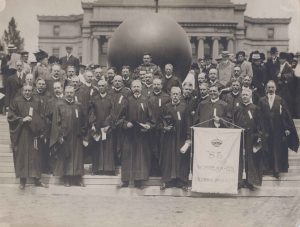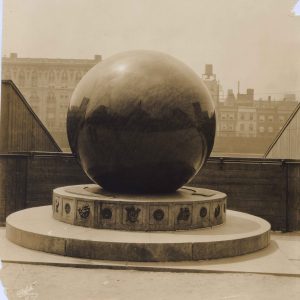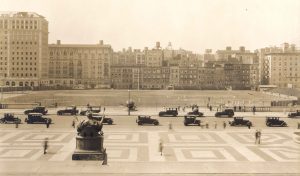“Meet me at the Sundial.” It’s heard all over campus, but have you ever wondered how that platform on College Walk is (or was) a sundial? Well, the Sundial is missing its “dial” or a 7-foot granite sunball that used to tell time.
What was the Sundial?

A gift from the Class of 1885 on the 25th anniversary of their graduation, this monument was presented on Commencement Day in 1910. When Columbia moved to Morningside Heights, the classes that attended Columbia College at 49th Street and Madison Avenue were not familiar with the new campus. To remedy that fact, alumni classes presented gifts, such as monuments, gates, and benches, to have a physical connection to the new Morningside Heights campus. This monument was designed by the University architects McKim, Mead and White. The inscription on the base reads: HORAM EXPECTA VENIET “Await the hour; it will come.”
How did it work?

Originally, an almost seven-feet-in-diameter sphere (now missing) used to sit atop the base. The sphere was made of polished dark green Vermont granite and weighed over fifteen tons. Professor Harold Jacoby CC 1885, the Rutherford Professor of Astronomy, made the calculations to calibrate the Sundial. Every day, the sunball would cast its shadow onto the two bronze plates on the platform (still there). The plates have markings for each month and each day of the year. At what would be 12:00 noon in New York City Standard time (not apparent solar time), the sunball’s shadow would fall on the inscribed date. The sundial was never off more than a fraction of a minute.
What happened to the sphere?

It cracked. In 1933, the sunball started showing fissures. By 1944, a large crack had widened and bronze rods were inserted to slow down the growth. Later, a steel band was clamped around the sphere to prevent further expansion and, as an additional precaution, the whole monument eventually had to be fenced off. On December 19, 1946, the sunball was removed.
Can’t the Sundial be fixed?

Over the years, there has been talk about “fixing” the sundial: whether this means installing a new sunball or another kind of dial. But the Sundial, as Provost Jonathan Cole argued in 2001, had already become a different symbol: it is the campus’s “free speech corner” or public speaking platform and all-around meeting place. While this was not its original purpose, the Sundial now plays a vital role on campus “as is.”
And one more thing . . .

At the time of the dedication (June 1910), the sunball was not ready. A plaster model was put in its place (see the dedication photographs for the duller, matte ball and the alumni standing on wooden steps). The 10-foot stone platform was not installed until November 1911; the granite sunball appeared in October 1912; and the completed monument was presented to the Trustees in May 1914.